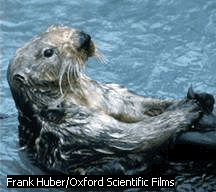
| Homepage | |||
| Facts | Pictures | Links | Books |

"Sea (great sea) otter (Enhydra lutris), rare, completely marine species of the North Pacific, usually in kelp beds; floats on its back with a stone on its chest, opening mollusks by smashing them on the stone; hindfeet large, broad, flipperlike; forefeet reduced; coat (the most expensive otter fur) thick, lustrous, reddish to dark brown, often grizzled; head and body, 76-120 cm; tail length, 25-37 cm; weight, 16-41 kg; hunted almost to extinction by 1910, now fully protected and gradually increasing in numbers."
From the Dictionary: sea otter noun an entirely aquatic marine otter of North Pacific coasts, formerly hunted for its dense fur. It is noted for its habit of floating on its back with a stone balanced on the abdomen, in order to crack open bivalve molluscs. Enhydra lutris, family Mustelidae

Prince William Sound was the site of a massive oil spill in 1989, when an Exxon Corporation tanker, the Exxon Valdez, ran aground on Bligh Reef at 12:04 Am on March 24. Because of delayed efforts to contain the spill and because of naturally strong winds and waves, about 10.9 million gallons of North Slope crude oil poured into the sound and eventually polluted thousands of miles of indented shoreline, as well as adjacent waters, as far south as the southern end of Shelikof Strait between Kodiak Island and the Alaskan Peninsula. An intensive effort was subsequently mounted to clean up the oil spill and restore the sound's damaged ecosystem.